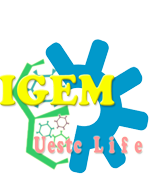Team:UESTC Life/Results and discussion
From 2013.igem.org
| Results and discussion |
|---|
Contents |
TCP Biodegradation achieved
- Growth of E.coli strain MC1061 transformed DhaA+P2A+HheC and DhaA gene in LB medium with inducer and 5mM TCP respectively, as the substrate was monitored in batch culture. The concentration of the products were confirmed using GC column(AC5). Growth resulted in disappearance of the substrate and simultaneous formation of biomass, 2,3-DCP, epichlorohydrin, chloropropanol, and glycerin. The result was screened by GC analysis. Above the degradation of TCP and the intermediate product 2,3-DCP indicate that multistep biodegradation are working. (Fig.1 and Fig.2). And cultivating in medium with 2,3-DCP, the concentration of epichlorohydrin can be detected(Fig.2). It means HheC degrade 2,3-DCP to epichlorohydrin. The degradation followed the desired path, TCP will be degraded to glycerol finally. The deficiency of our project is chloropropanol and glycerin couldn’t be detected by the columns. In the future, new columns and new methods will be used.
Fig.1. E.coli MC1061 carried DhaA+P2A+HheC gene incubated in LB medium with TCP(5mM) at 30℃. The concentration of TCP and it mediate product 2,3-DCP were measured by GC. 2,3-DCP was degraded at the same time.
Fig.2. E.coli MC1061 carried DhaA incubated in LB medium with TCP(5mM) at 30℃. The concentration of TCP and its mediate product 2,3-DCP were measured by GC. 2,3-DCP couldn’t be degraded.
Fig.3. E.coli MC1061 carried DhaA+P2A+HheC gene incubated in LB medium with 2,3-DCP(5mM) at 30℃. The concentration of 2,3-DCP and its mediate product epichlorohydrin were measured by GC.
γ-HCH Biodegradation and F2A cleaving achieved
P2A being an excellent linker in chimeric protein
Polycistronic co-expression system constructed
Vectors and Parts
Future Work
 "
"

